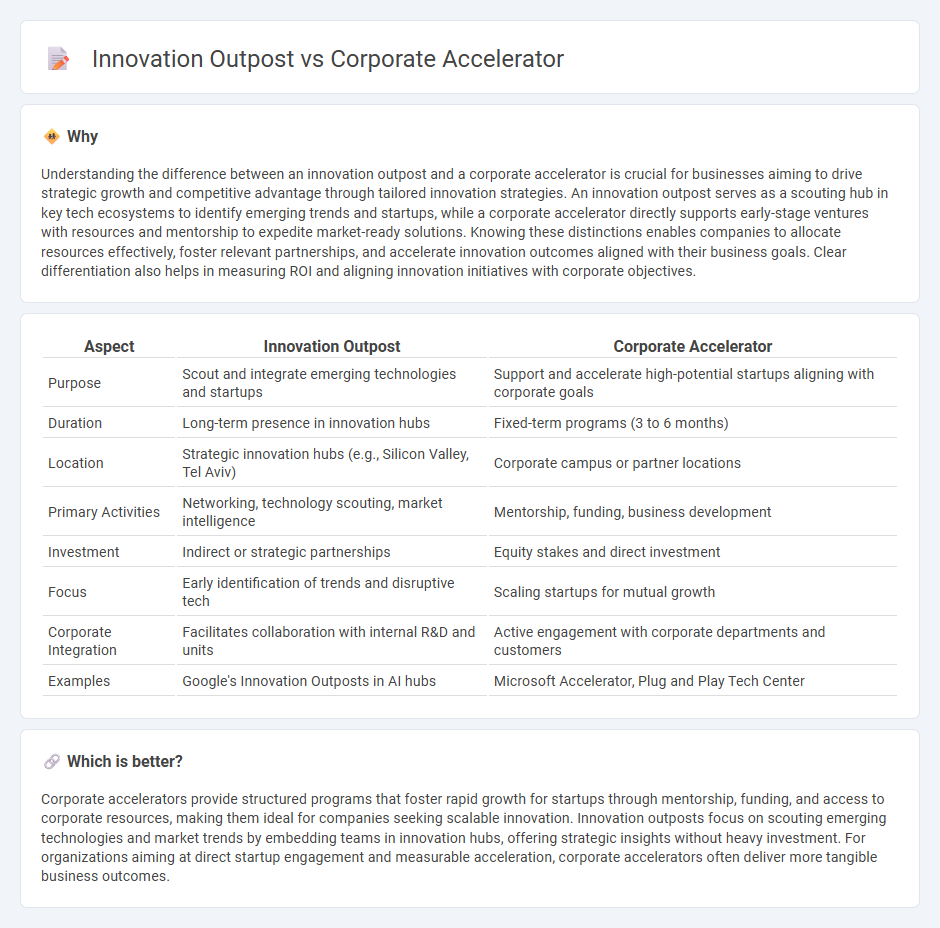
Innovation outposts serve as strategic hubs for monitoring emerging technologies and startups, enabling corporations to stay ahead in rapidly evolving markets. Corporate accelerators focus on nurturing early-stage startups through mentorship, funding, and resources, driving collaborative innovation aligned with company goals. Explore how each model can transform your innovation strategy and foster competitive advantage.
Why it is important
Understanding the difference between an innovation outpost and a corporate accelerator is crucial for businesses aiming to drive strategic growth and competitive advantage through tailored innovation strategies. An innovation outpost serves as a scouting hub in key tech ecosystems to identify emerging trends and startups, while a corporate accelerator directly supports early-stage ventures with resources and mentorship to expedite market-ready solutions. Knowing these distinctions enables companies to allocate resources effectively, foster relevant partnerships, and accelerate innovation outcomes aligned with their business goals. Clear differentiation also helps in measuring ROI and aligning innovation initiatives with corporate objectives.
Comparison Table
| Aspect | Innovation Outpost | Corporate Accelerator |
|---|---|---|
| Purpose | Scout and integrate emerging technologies and startups | Support and accelerate high-potential startups aligning with corporate goals |
| Duration | Long-term presence in innovation hubs | Fixed-term programs (3 to 6 months) |
| Location | Strategic innovation hubs (e.g., Silicon Valley, Tel Aviv) | Corporate campus or partner locations |
| Primary Activities | Networking, technology scouting, market intelligence | Mentorship, funding, business development |
| Investment | Indirect or strategic partnerships | Equity stakes and direct investment |
| Focus | Early identification of trends and disruptive tech | Scaling startups for mutual growth |
| Corporate Integration | Facilitates collaboration with internal R&D and units | Active engagement with corporate departments and customers |
| Examples | Google's Innovation Outposts in AI hubs | Microsoft Accelerator, Plug and Play Tech Center |
Which is better?
Corporate accelerators provide structured programs that foster rapid growth for startups through mentorship, funding, and access to corporate resources, making them ideal for companies seeking scalable innovation. Innovation outposts focus on scouting emerging technologies and market trends by embedding teams in innovation hubs, offering strategic insights without heavy investment. For organizations aiming at direct startup engagement and measurable acceleration, corporate accelerators often deliver more tangible business outcomes.
Connection
Innovation outposts and corporate accelerators are interconnected as strategic platforms enabling established companies to scout emerging technologies and startups while accelerating their development through structured programs. Innovation outposts provide real-time market insights and access to disruptive innovations, feeding corporate accelerators with high-potential ventures for mentorship, funding, and integration. This symbiotic relationship enhances corporate innovation pipelines, driving growth and competitive advantage in rapidly evolving industries.
Key Terms
Internalization
Corporate accelerators drive internalization by embedding startup collaboration within existing company frameworks, accelerating technology integration and market adaptation. Innovation outposts focus on external knowledge acquisition by establishing strategic presence in innovation hubs, scouting emerging trends and startups globally. Discover how each model uniquely enhances corporate innovation strategies by internalizing cutting-edge solutions.
Ecosystem Access
Corporate accelerators provide startups with structured mentorship, funding opportunities, and direct engagement within the company's core operations, fostering rapid integration into the corporate ecosystem. Innovation outposts, strategically located in innovation hubs, focus on scouting emerging technologies and connecting the corporation with local startups and research institutions to enhance ecosystem access. Explore the distinct roles and benefits of these models to optimize your corporate innovation strategy.
Strategic Alignment
Corporate accelerators drive strategic alignment by fostering startups that closely match the company's core business objectives and market focus, accelerating internal innovation through direct investment and mentorship. Innovation outposts emphasize scanning emerging ecosystems and technologies, aligning strategy by identifying long-term trends and potential disruptive opportunities outside traditional market boundaries. Explore how aligning accelerator programs and innovation outposts can maximize your company's strategic innovation impact.
Source and External Links
10 Corporate Accelerator Examples You Should Know About - Bundl - Corporate accelerators are programs run by established companies to partner with startups, providing them mentoring, funding, and resources in a structured, fixed-term format to accelerate growth and innovate in various industries.
Corporate accelerator - Wikipedia - A corporate accelerator is a seed accelerator sponsored by a for-profit corporation that supports early-stage startups with mentorship, capital, and office space, aligning the program with the sponsoring company's strategic goals such as innovation and venture investment.
All About Corporate Accelerators - Definition | What Is It? | Explanation - Corporate accelerators run fixed-term, cohort-based programs offering startups seed capital, mentorship, connections, and sales support, ending in demo days where startups pitch for further partnership or investment with the sponsoring corporation.
 dowidth.com
dowidth.com